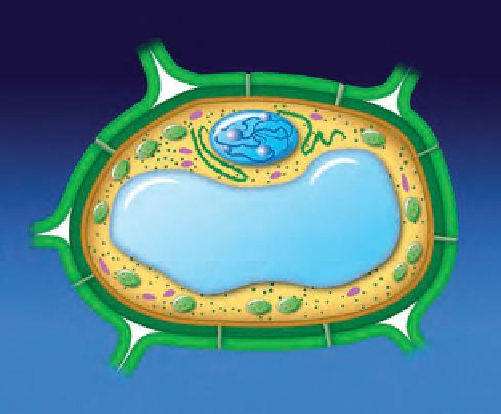Agriculture Reference
In-Depth Information
Plant tissues, and the cells that form them, work
together to enable plants to carry out the functions
essential for life. As in humans, specialized tissues
support the plant body, enable movement of
substances around it, manufacture the substances
it requires to live and to reproduce and protect it
from its environment. An understanding of how
these components work and interact with each other
enables gardeners to provide successfully for their
plants' needs thus optimizing their growth.
The internal structure (anatomy) of the plant is made
up of different tissues. Each
tissue
is a collection
of specialized cells carrying out one function, such
as xylem tissue conducting water and nutrients. An
organ
is made up of a group of tissues carrying out a
specific function, such as a leaf producing sugars for
the plant.
outer cellulose cell wall and an inner cell membrane,
which enclose the cell contents suspended in the jelly-
like cytoplasm.
X
The
cell wall
is laid down in a mesh of cellulose
fi bres which allows the wall to stretch as the cell
expands. Once the cell is mature, the cell wall
loses its elasticity and sets the permanent shape
of the cell. In living cells, dissolved substances
can pass freely through the open mesh of the cell
wall, although larger items such as fungal spores
can be excluded. Within the mesh framework
are many apertures that, in living cells such as
parenchyma, allow for strands of cytoplasm
(called
plasmodesmata
) to interconnect between
adjacent cells. These strands allow the passage
of substances between cells. When a plant wilts,
the plasmodesmata normally retain their links with
adjacent cells and wilting is reversible. However,
in some situations they may break (plasmolysis)
and the plant is not able to recover (see p. 120).
In all tissues, the cell walls of adjoining cells
are held together by calcium pectate (pectin), a
glue-like substance which is an important setting
ingredient in jam-making. Some types of cell
(e.g. xylem vessels) die in order to achieve their
usefulness. Here, the wall of cellulose becomes
thickened by additional cellulose layers and lignin,
which is a strong, waterproof substance, and the
A
tissue
is a collection of cells carrying out a
specific function
.
Plant cells and their contents
Without the use of a microscope, we would not be
able to see cells, since they are very small, typically
about a twentieth of a millimetre in size. A simple,
unspecialized plant cell (Figure 6.2) consists of an
Nucleus containing chromosomes
Cell membrane
Chloroplast
Endoplasmic
reticulum
Cytoplasm
Mitochondrion
Plasmodesmata
Vacuole
Starch grains
Cell wall
Figure 6.2
An unspecialized plant cell



















